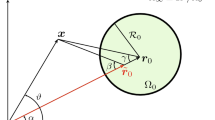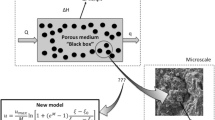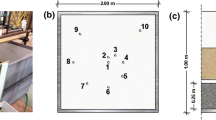Abstract
When fluid motion is induced through a porous medium, the distance travelled depends on the energy exerted and overall resistance to flow. Ostensibly intuitive, this concept of reach has proven elusive not only in delineation, but even mathematical definition. In wells surrounded by a homogeneous medium it is a circle and thus characterised by a single number referred to as the radius of influence. The simple definition thereof as the locus of zero radial velocity yields an infinite or severely overestimated result, and tempts custom modifications to reconcile the estimates with reality. In environmental applications such as aquifer sparging wells, hydraulic and petroleum wells, natural gas and landfill gas wells, the medium is often highly heterogeneous. The analysis presented herein shows that the zone of collection or dispersal changes shape dramatically based on the interrelation of resistance to flow posed by subdomains of distinct permeabilities. In contrast to the isotropic case, the mere presence of heterogeneity suggests a natural and unambiguous definition of this zone of interest as a set of separatrices connecting stagnation points in the flow field, and results in realistic estimates. The variability of its shape is remarkable and relates to the structural diversity of the parameter space underpinning the flow field. The findings help explain the longstanding problem of a reliable delimitation of these wells’ reach in practice.









Similar content being viewed by others
References
McCray JE, Falta RW (2005) Numerical simulation of air sparging for remediation of NAPL contamination. Groundwater 35:99–110
Houben GJ (2015) Review: hydraulics of water wells-flow laws and influence of geometry. Hydrogeol J 23:1633–1657
Javandel I, Tsang C-F (1986) Capture-zone type curves: a tool for aquifer cleanup. Ground Water 24(5):616–625
Kompani-Zare M, Zhan H, Samani N (2005) Analytical study of capture zone of a horizontal well in a confined aquifer. J Hydrol 307:48–59
Asadi-Aghbolaghi M, Rakhshandehroo GR, Kompani-Zare M (2011) Analytical solutions for the capture zone of a pum** well near a stream. Hydrogeol J 19:1161–1168
Pechstein A, Attinger S, Kreig R, Copty NK (2016) Estimating transmissivity from single-well pum** tests in heterogeneous aquifers. Water Resour Res 52(1):495–510
Kuchuk FJ (2009) Radius of investigation for reserve estimation from pressure transient well tests. Soc Pet Eng 120515:1–23
Sobbi FA, Badakhshan A (1996) Radius of investigation for well tests in dual porosity reservoirs. J Can Pet Technol 35(06):96–0605
Bresciani E, Shandilya RN, Kang PK, Lee S (2020) Well radius of influence and radius of investigation: what exactly are they and how to estimate them? J Hydrol 583:124646
Podgorney RK, Ritzi RW Jr (1997) Capture zone geometry in a fractured carbonate aquifer. Ground Water 35(6):1040–1049
Xu Y, van Tonder GJ (2002) Capture zone simulation for boreholes located in fractured dykes using the linesink concept. Water SA 28(2):165–169
Bakr MI, Butler AP (2004) Worth of head data in well-capture zone design: deterministic and stochastic analysis. J Hydrol 290:202–216
Ataie-Ashtiani B, Shafei B, Rashidian-Dezfouli H, Mohamadzadeh M (2012) Capture zone of a partially penetrating well with skin effects in confined aquifers. Transp Porous Media 91:437–457
Frind EO, Molson JW (2018) Issues and options in the delineation of well capture zones under uncertainty. Ground Water 56(3):366–376
Al-Hussainy R, Ramey HJ Jr., Crawford PB (1966) The flow of real gases through porous media. J Pet Technol 18(5):624–636
Nec Y, Huculak G (2019) Landfill gas flow: collection by horizontal wells. Transp Porous Media 130:769–797
Halvorsen D, Nec Y, Huculak G (2019) Horizontal landfill gas wells: geometry, physics of flow and connection with the atmosphere. Phys Chem Earth 113:50–62
Whitaker S (1996) The Forchheimer equation: a theoretical development. Transp Porous Media 25:27–61
Brinkman HC (1947) Fluid flow in a porous medium. Appl Sci Res Sec A1(27):143–149
Durlofsky L, Brady JF (1987) Analysis of the Brinkman equation as a model for flow in porous media. Phys Fluids 30:3329–3341
Awasthi P, Kumar M, Nec Y (2023) Effects of anisotropy in tridimensional diffusion: flow patterns and transport efficiency. SIAM J Appl Math 83(2):460–483
Benner ML, Mohtar RH, Lee LS (2002) Factors affecting air sparging remediation systems using field data and numerical simulations. J Hazard Mater 95:305–329
Hyman JD, Karra S, Makedonska N, Gable CW, Painter SL, Viswanathan HS (2015) dfnWorks: a discrete fracture network framework for modeling subsurface flow and transport. Comp Geosci 84:10–19
Zhang P, Zhang Y, Zhang W, Tian S (2022) Numerical simulation of gas production from natural gas hydrate deposits with multi-branch wells: influence of reservoir properties. Energy 238((A)):121738
McCray JE, Falta RW (1996) Defining the air sparging radius of influence for groundwater remediation. J Contam Hydrol 24:25–52
Fulks WB, Guenther RB, Roetman EL (1971) Equations of motion and continuity for fluid flow in a porous medium. Acta Mech 12:121–129
Whitaker S (1986) Flow in porous media I: a theoretical derivation of Darcy’s law. Transp Porous Media 1:3–25
Agarwal N, Semmens MJ, Novak PJ, Hozalski RM (2005) Zone of influence of a gas permeable membrane system for delivery of gases to groundwater. Water Resour Res 41:05017
Lundegard PD, LaBrecque D (1995) Air sparging in a sandy aquifer (Florence, Oregon, U.S.A.): actual and apparent radius of influence. J Contam Hydrol 19:1–27
Wise WR, Townsend TG (2011) One-dimensional gas flow models for municipal solid waste landfills: cylindrical and spherical symmetries. J Environ Eng 137(6):514–516
Vigneault H, Lefebvre R, Nastev M (2004) Numerical simulation of the radius of influence for landfill gas wells. Vadose Zone J 3:909–916
Lee J-H, Woo HJ, Jeong K-S, Park K-S (2016) The radius of influence of a combined method of in situ air sparging and soil vapor extraction in the intertidal sediments of Gomso Bay on the west coast of South Korea. SpringerPlus 5:1388
Nec Y (2021) Singularities in weakly compressible flow through a porous medium. Fluid Dyn Res 53:045507
Gingras MK, Pemberton SG, Mendoza CA, Henk F (2022) Assessing the anisotropic permeability of Glossifungites surfaces. Pet Geosci 5:349–357
Bradbury KR, Muldoon MA (1994) Effects of fracture density and anisotropy on delineation of wellhead-projection areas in fractured-rock aquifers. Hydrogeol J 2:17–23
Nec Y, Huculak G (2020) Exact solutions to radial flow in a porous medium with variable permeability. Phys Fluids 32:077108
Tretiakova K, Nec Y (2023) Separable solutions to non-linear anisotropic diffusion equation in elliptic coordinates. Philos Trans R Soc A 381:20220077
Zeng G, Liu L, Xue Q, Wan Y, Ma J, Zhao Y (2017) Experimental study of the porosity and permeability of municipal solid waste. Environ Prog Sustain Energy 36:1694–1699
Panda MN, Lake LW (1994) Estimation of single-phase permeability from parameters of particle-size distribution. Am Assoc Pet Geol Bull 78(7):1028–1039
Sahu CK, Flynn MR (2015) Filling box flows in porous media. J Fluid Mech 782:455–478
Carman PC (1937) Fluid flow through granular beds. Trans Inst Chem Eng 15:150–167
Henderson N, Brêttas JC, Sacco WF (2010) A three-parameter Kozeny–Carman generalized equation for fractal porous media. Chem Eng Sci 65:4432–4442
Sanchez-Villa X, Guadagnini A, Carrera J (2006) Representative hydraulic conductivities in saturated groundwater flow. Rev Geophys 44(3):3002
Dagan G, Lessoff SC (2007) Transmissivity upscaling in numerical aquifer models of steady well flow: unconditional statistics. Water Resour Res 43(5):05431
Indelman P, Lessoff SC, Dagan G (2006) Analytical solution to transport in three-dimensional heterogeneous well capture zones. J Contam Hydrol 87:1–21
Cardiff M, Bakhos T, Kitanidis P, Barrash W (2013) Aquifer heterogeneity characterization with oscillatory pum**: sensitivity analysis and imaging potential. Water Resour Res 49(9):5395–5410
Rupert CP, Miller CT (2007) An analysis of polynomial chaos approximations for modeling single-fluid-phase flow in porous medium systems. J Comput Phys 226(2):2175–2205
Brunetti GFA, Fallico C, De Bartolo S, Severino G (2022) Well-type steady flow in strongly heterogeneous porous media: an experimental study. Water Resour Res 58(5):2021–030717
Gómez-Hernández JJ, Wen X-H (1998) To be or not to be multi-Gaussian? a reflection on stochastic hydrogeology. Adv Water Resour 21(1):47–61
Tahmasebi P, Javadpour F, Sahimi M (2016) Stochastic shale permeabiilty matching: three-dimensional charaterization and modeling. Int J Coal Geol 165:231–242
Zha Y, Cao B, Li F, Ye Q, Zhu S, Zhou W, **ong R (2023) Pore structure and permeability variations during gas displacement in unconsolidated sandstone reservoirs through CT reconstruction analysis. Geofluids 2023:3701163
Author information
Authors and Affiliations
Contributions
YN conceptualised the project and wrote the main manuscript text. MB completed all numerical work. All authors reviewed the manuscript.
Corresponding author
Ethics declarations
Conflict of interest
The authors declare no competing interests.
Additional information
Publisher's Note
Springer Nature remains neutral with regard to jurisdictional claims in published maps and institutional affiliations.
Rights and permissions
Springer Nature or its licensor (e.g. a society or other partner) holds exclusive rights to this article under a publishing agreement with the author(s) or other rightsholder(s); author self-archiving of the accepted manuscript version of this article is solely governed by the terms of such publishing agreement and applicable law.
About this article
Cite this article
Boham, M., Nec, Y. Definitely not a circle: on the variability of the zone of influence in porous media flows. J Eng Math 142, 3 (2023). https://doi.org/10.1007/s10665-023-10289-0
Received:
Accepted:
Published:
DOI: https://doi.org/10.1007/s10665-023-10289-0




